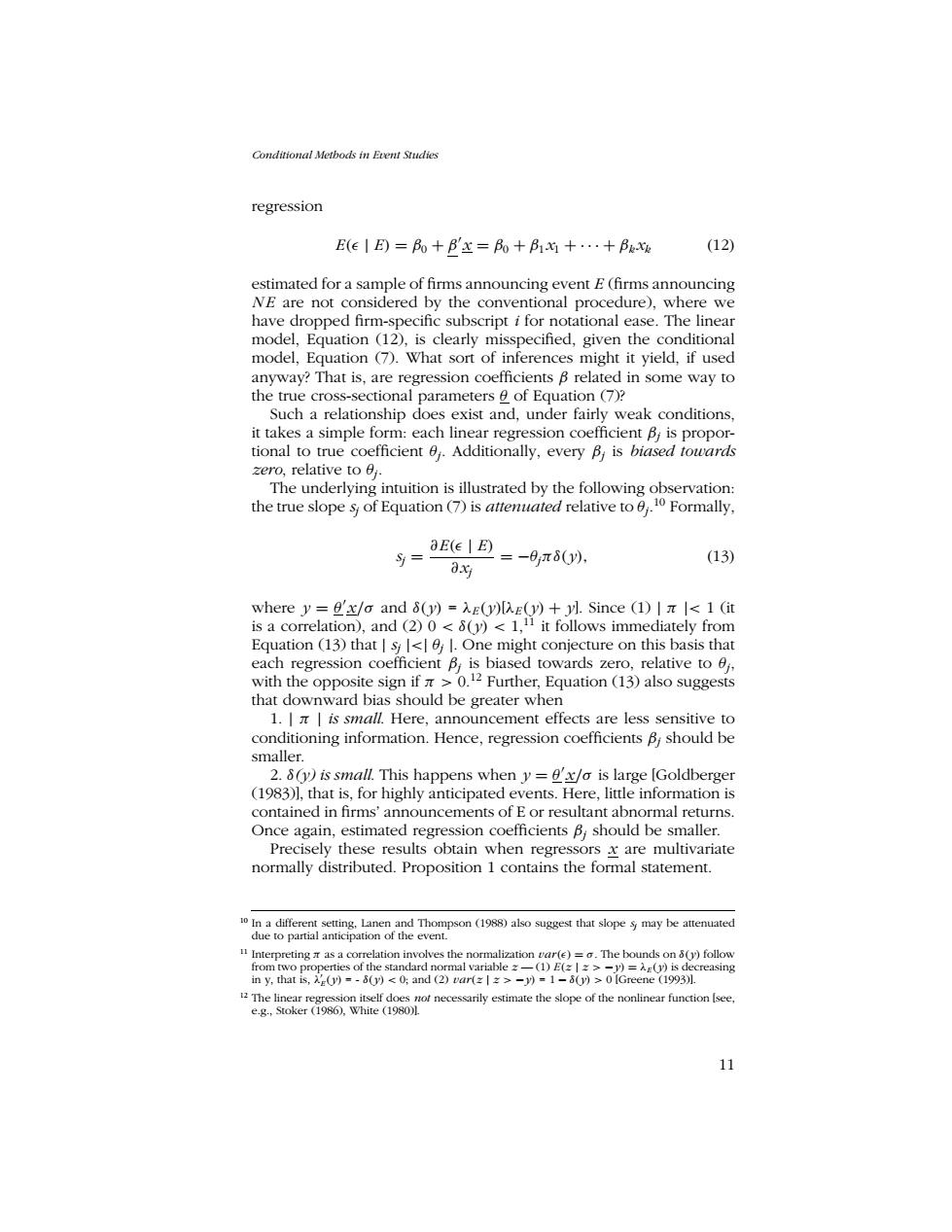正在加载图片...

Conditional Metbods in Event Studies regression E(E I E)=Bo+B'x=Bo+B1x++Baxe (12) estimated for a sample of firms announcing event E(firms announcing NE are not considered by the conventional procedure),where we have dropped firm-specific subscript i for notational ease.The linear model,Equation (12),is clearly misspecified,given the conditional model,Equation (7).What sort of inferences might it yield,if used anyway?That is,are regression coefficients B related in some way to the true cross-sectional parameters 0 of Equation (7)? Such a relationship does exist and,under fairly weak conditions, it takes a simple form:each linear regression coefficient Bi is propor- tional to true coefficient 0j.Additionally,every B is biased towards zero,relative to 0j. The underlying intuition is illustrated by the following observation: the true slope sy of Equation (7)is attenuated relative to 0.10 Formally, S= 8Ee|E=-0,π80), (13) oxi where y=E'x/aand6(y)=λE(y)[入e()+yl.Since(1)|π|<1(it is a correlation),and (2)0<(y)<1,1 it follows immediately from Equation (13)that I s<0 I.One might conjecture on this basis that each regression coefficient B,is biased towards zero,relative to 0, with the opposite sign if >0.12 Further,Equation (13)also suggests that downward bias should be greater when 1.is small.Here,announcement effects are less sensitive to conditioning information.Hence,regression coefficients B,should be smaller. 2.8(y)is small.This happens when y='x/a is large [Goldberger (1983)1,that is,for highly anticipated events.Here,little information is contained in firms'announcements of E or resultant abnormal returns Once again,estimated regression coefficients B,should be smaller. Precisely these results obtain when regressors x are multivariate normally distributed.Proposition 1 contains the formal statement. o In a different setting.Lanen and Thompson (1988)also suggest that slope s may be attenuated due to partial anticipation of the event. Interpreting as a correlation involves the normalization var(e)=a.The bounds on ()follow from two properties of the standard normal variable z-(1)E(z Iz>-y)=()is decreasing in y,that is,(y)=-8(y)<0;and (2)var(z>-y)=1-8(y)>0 [Greene (1993)l. The linear regression itself does not necessarily estimate the slope of the nonlinear function (see. e.g.,Stoker (1986),White (1980)L 11Conditional Methods in Event Studies regression E(² | E) = β0 + β0 x = β0 + β1x1 +···+ βkxk (12) estimated for a sample of firms announcing event E (firms announcing N E are not considered by the conventional procedure), where we have dropped firm-specific subscript i for notational ease. The linear model, Equation (12), is clearly misspecified, given the conditional model, Equation (7). What sort of inferences might it yield, if used anyway? That is, are regression coefficients β related in some way to the true cross-sectional parameters θ of Equation (7)? Such a relationship does exist and, under fairly weak conditions, it takes a simple form: each linear regression coefficient βj is proportional to true coefficient θj . Additionally, every βj is biased towards zero, relative to θj . The underlying intuition is illustrated by the following observation: the true slope sj of Equation (7) is attenuated relative to θj . 10 Formally, sj = ∂E(² | E) ∂xj = −θjπδ(y), (13) where y = θ0 x/σ and δ(y) = λE (y)[λE (y) + y]. Since (1) | π |< 1 (it is a correlation), and (2) 0 < δ(y) < 1,11 it follows immediately from Equation (13) that | sj |<| θj |. One might conjecture on this basis that each regression coefficient βj is biased towards zero, relative to θj , with the opposite sign if π > 0.12 Further, Equation (13) also suggests that downward bias should be greater when 1. | π | is small. Here, announcement effects are less sensitive to conditioning information. Hence, regression coefficients βj should be smaller. 2. δ(y) is small. This happens when y = θ0 x/σ is large [Goldberger (1983)], that is, for highly anticipated events. Here, little information is contained in firms’ announcements of E or resultant abnormal returns. Once again, estimated regression coefficients βj should be smaller. Precisely these results obtain when regressors x are multivariate normally distributed. Proposition 1 contains the formal statement. 10 In a different setting, Lanen and Thompson (1988) also suggest that slope sj may be attenuated due to partial anticipation of the event. 11 Interpreting π as a correlation involves the normalization var(²) = σ. The bounds on δ(y) follow from two properties of the standard normal variable z — (1) E(z | z > −y) = λE (y) is decreasing in y, that is, λ0 E (y) = - δ(y) < 0; and (2) var(z | z > −y) = 1 − δ(y) > 0 [Greene (1993)]. 12 The linear regression itself does not necessarily estimate the slope of the nonlinear function [see, e.g., Stoker (1986), White (1980)]. 11